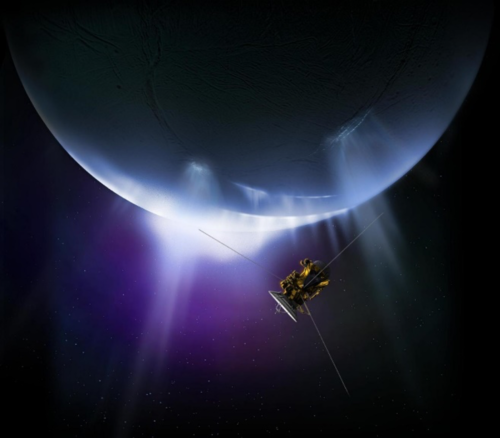If there is life out there, can we detect it?
Scientists at Freie Universität Berlin publish two experimental studies in journal Astrobiology
№ 101/2020 from Jun 16, 2020
Instruments on-board future space missions are capable of detecting amino acids, fatty acids, and peptides, and even identify ongoing biological processes on ocean moons in our Solar System. These are the exciting conclusions reached from two studies by an international team led by scientists of the Planetary Sciences research group at Freie Universität Berlin. The two studies were funded by the European Research Council under Consolidator grant 724908-Habitat OASIS and published in the peer-reviewed scientific journal Astrobiology.
Enceladus, one of Saturn’s moons, is known to emit plumes of gas and ice grains formed from the moon’s subsurface ocean, located beneath an ice crust, into space. A similar phenomenon is suspected to occur on Jupiter’s moon Europa. The compositions of ice grains emitted from such water worlds can be sampled by spacecraft intercepting the particles, using so-called impact ionization mass spectrometers (Figure 1). Scientists at Freie Universität Berlin have undertaken unique laboratory experiments, which accurately simulate the mass spectra of ice grains measured in space. “In our first study, we conducted experiments using amino acids, fatty acids, and peptides to predict the spectral appearance of these organic biomolecules, which could potentially be embedded in the ice grains,” explains Fabian Klenner, lead author of both studies. “Our data show that these potentially biogenic organic molecules are clearly identifiable, even at very low concentrations.”
These results led the researchers to the next question: Could they identify ongoing biological processes on ocean worlds using a spacecraft-based mass spectrometer? “Just identifying these biosignatures is not enough,” says Prof. Frank Postberg, co-lead author of the second study and head of the Planetary Sciences research group. “Amino acids for example can also be produced just by chemistry, without the involvement of life. We need to identify a certain spectral pattern of different amino acids to be sure that biological processes are at work.” The team investigated the behavior of mixtures of potential biomolecules in a realistic ocean world scenario, with numerous background compounds added to the samples and was able to differentiate between abiotic and biotic organic ‘fingerprints’ in the resulting mass spectra. “Finding chemistry indicative of life within an extraterrestrial water world by sampling just a few tiny ice grains would be a crucial step towards the detection of life beyond Earth and we have shown that this is possible with a mass spectrometer mounted on a spacecraft flying by,” Fabian Klenner added.
The results of this work are particularly timely, with the launch of NASA’s Europa Clipper mission to Jupiter’s moon Europa scheduled for 2024. The spacecraft will carry a mass spectrometer suitable for detecting biomolecules, with the Planetary Sciences group of Freie Universität being part of the research team.
The two international studies were conducted in collaboration with Ruprecht-Karls-Universität Heidelberg, NASA’s Jet Propulsion Laboratory in California, the Leibniz-Institute of Surface Engineering in Leipzig, Universität Leipzig, the University of Colorado in Boulder, the Southwest Research Institute in Texas, and Cornell University in New York.
Press photo
Further Information
Publications
- Fabian Klenner, Frank Postberg, Jon Hillier, Nozair Khawaja, René Reviol, Ferdinand Stolz, Morgan L. Cable, Bernd Abel, and Lenz Nölle (2020a) Analog Experiments for the Identification of Trace Biosignatures in Ice Grains from Extraterrestrial Ocean Worlds. Astrobiology 20(2):179–189. DOI: 10.1089/ast.2019.2065
- Fabian Klenner, Frank Postberg, Jon Hillier, Nozair Khawaja, Morgan L. Cable, Bernd Abel, Sascha Kempf, Christopher R. Glein, Jonathan I. Lunine, Robert Hodyss, René Reviol, and Ferdinand Stolz (2020b) Discriminating Abiotic and Biotic Fingerprints of Amino Acids and Fatty Acids in Ice Grains Relevant to Ocean Worlds. Astrobiology 20:online ahead of print. DOI: 10.1089/ast.2019.2188
Contact
- Fabian Klenner, Institute of Geological Sciences, Freie Universität Berlin, Telephone: +4930838-66281, Email: f.klenner@fu-berlin.de
- Prof. Dr. Frank Postberg, Institute of Geological Sciences, Freie Universität Berlin, Telephone: +4930838-70508, Email: frank.postberg@fu-berlin.de

